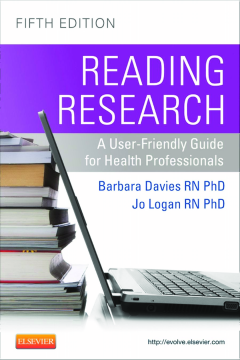
Additional Information
Book Details
Abstract
This practical beginner-level introduction to health sciences research is ideal for both students and health professionals. It assumes the reader has little or no experience with analyzing published research, and provides guidelines for reading and understanding research articles, as well as information about important elements of published research (e.g., research methods, common terminology, data analysis and results). The book also briefly discusses how research results can be used and applied to practice.
- Concise overview of health sciences-related research - a fast read for students looking to maximize study time
- Easy-to-read conversational style - simplified style encourages students
- Helpful, succinct tips - useful, practical advice for those who are new to the subject
- An accompanying website provides up-to-date links for relevant research projects and other research-related sites, and offers Reader's Companion Worksheets
- Expanded Chapters 2 and 3 now include more on mixed method research
- New information about systematic reviews including an example of how to read a forest plot
- Descriptive and interpretive phenomenology is explained.
- NEW: Includes brief discussion about using social media to find research
- NEW: Interactive forms on accompanying website
Table of Contents
| Section Title | Page | Action | Price |
|---|---|---|---|
| Front Cover | Cover | ||
| Reading Research: A User - Friendly Guide for Health Professionals | i | ||
| Copyright | ii | ||
| Contents | iii | ||
| About the Authors | v | ||
| Preface | vii | ||
| Acknowledgements | ix | ||
| Chapter 1: Introduction | 1 | ||
| Why read research articles? | 2 | ||
| Some friendly advice about reading research articles | 2 | ||
| Check out the reader's companion worksheets | 3 | ||
| Chapter 2: Easy Steps for Reading Research | 5 | ||
| Title | 5 | ||
| Abstract | 5 | ||
| Introduction | 6 | ||
| Methods | 7 | ||
| Design | 7 | ||
| Part 1: Qualitative Design Methods | 9 | ||
| Rigour in Qualitative Studies | 11 | ||
| Sample and Setting | 13 | ||
| Data Collection | 13 | ||
| Data Analysis and Results | 14 | ||
| Part 2: Quantitative Design Methods | 14 | ||
| Experimental Designs | 16 | ||
| Non-Experimental Designs | 17 | ||
| Rigour in Designing Quantitative Studies | 18 | ||
| Sample | 20 | ||
| Sample Size Requirements | 20 | ||
| Data Collection | 21 | ||
| How to Judge Whether a Measurement Tool or Survey Has Been Validated | 21 | ||
| Sensitivity and Specificity | 22 | ||
| Data Analysis and Results | 23 | ||
| Descriptive Statistics | 23 | ||
| Inferential Statistics | 24 | ||
| Common statistical concepts and terms | 24 | ||
| Part 3: Mixed Methods Research | 28 | ||
| Mixed Methods Data and Analysis | 29 | ||
| Sequential | 29 | ||
| Concurrent | 30 | ||
| Discussion | 31 | ||
| A final suggestion: the acknowledgements | 32 | ||
| Chapter 3: Finding Interesting Research Results | 33 | ||
| Where and how to start? | 33 | ||
| steps-PICO | 33 | ||
| Define Your Clinical Question | 33 | ||
| Search a Database for Relevant Research | 33 | ||
| Search terms | 34 | ||
| Example: at the search prompt in PubMed, type in ``older adults, assessment, and confusion´´ | 34 | ||
| Example: at the search prompt in PubMed, type in ``delirium´´ | 35 | ||
| How far back should you search? | 36 | ||
| Searching the internet | 38 | ||
| Web portals | 40 | ||
| Other types of databases | 40 | ||
| Keeping up to date | 41 | ||
| What is RSS? | 41 | ||
| Social media: facebook and youtube | 41 | ||
| Chapter 4: Using Research Results | 43 | ||
| Research utilization | 43 | ||
| The Questions to Ask | 43 | ||
| Clinical practice guidelines | 45 | ||
| Appraisal of Guidelines for Research and Evaluation | 46 | ||
| Practice Guideline Web Sites | 46 | ||
| The decision to use research results | 47 | ||
| Gathering Support and Resources | 47 | ||
| Want to learn more? | 48 | ||
| Glossary | 50 | ||
| Bibliography | 49 | ||
| Journals that Publish Peer-Reviewed Research | 55 | ||
| Worksheet 1: Qualitative Research: The Reader’s Companion Worksheet | 56 | ||
| Worksheet 2: Quantitative Research: The Reader’s Companion Worksheet | 61 | ||
| Worksheet 3: Mixed Methods Research: The Reader’s Companion Worksheet | 68 | ||
| Worksheet 4: Systematic Reviews: The Reader’s Companion Worksheet | 77 | ||
| Worksheet 5: Using Research Results: The Readers’s Companion Worksheet | 81 | ||
| Inside Front Cover | 83 |
